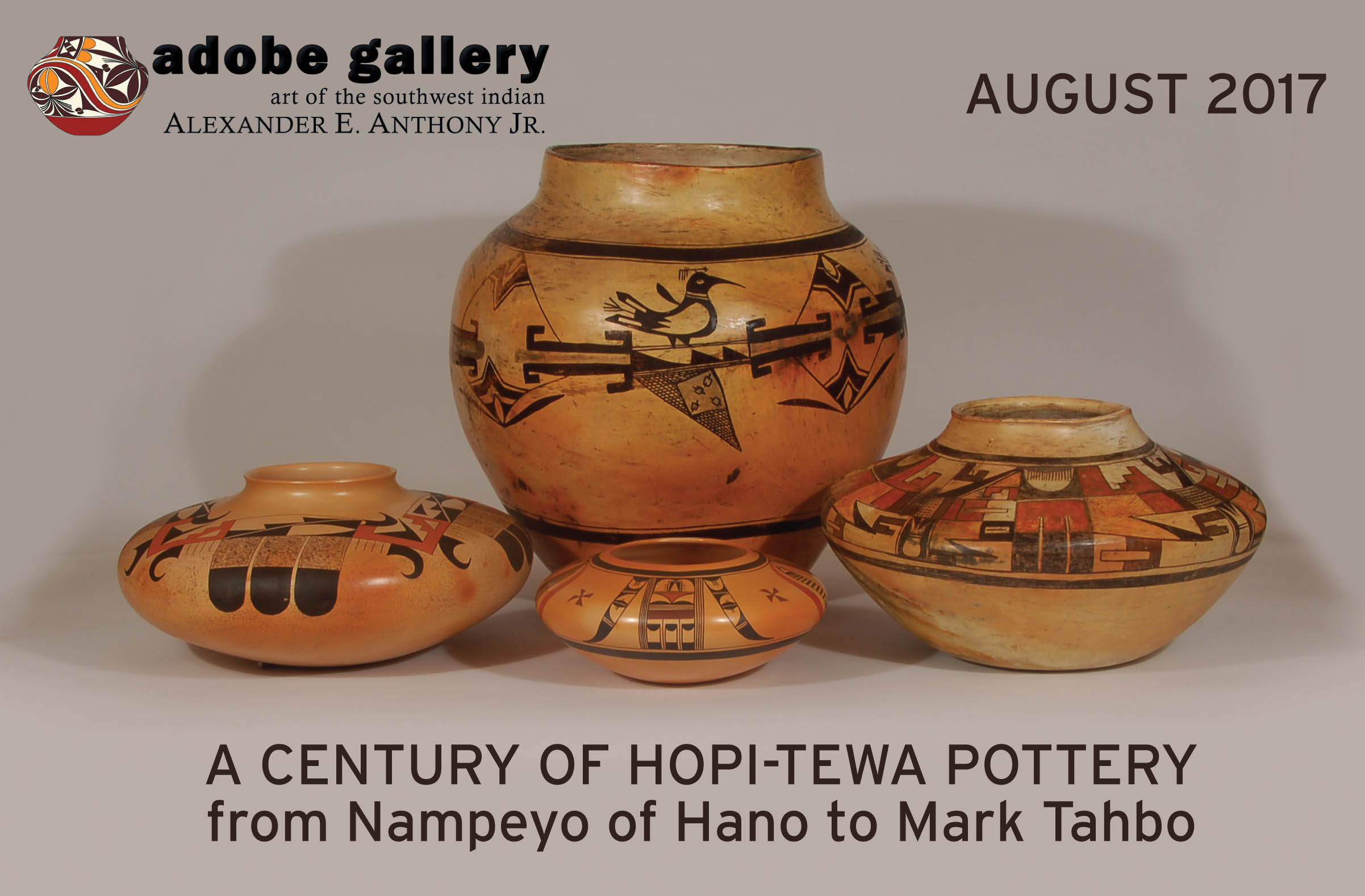Small Hopi Pueblo Jar with Eagle Tail Design by Mark Tahbo - 26017
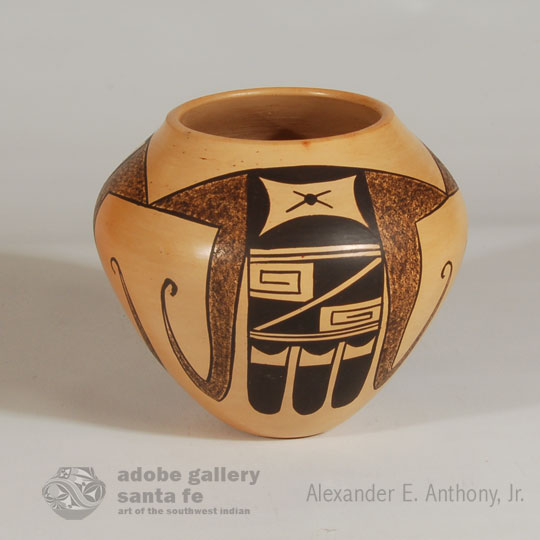 An innovation by Mark Tahbo is his choice of clay. The artists at Hopi have a choice of clay from the Jeddito region, just behind the village of Polacca, clay from the middle village Sichomovi at First Mesa, or Sikyatki clay from the prehistoric ruins so important to the career of Nampeyo. In this jar, Mark selected clay from Jeddito which fires to a beautiful orange blush.
An innovation by Mark Tahbo is his choice of clay. The artists at Hopi have a choice of clay from the Jeddito region, just behind the village of Polacca, clay from the middle village Sichomovi at First Mesa, or Sikyatki clay from the prehistoric ruins so important to the career of Nampeyo. In this jar, Mark selected clay from Jeddito which fires to a beautiful orange blush.
Would you like to purchase or read more about this Mark Tahbo jar?
Tesuque Pueblo Rosy Cheek Rain God - 26002
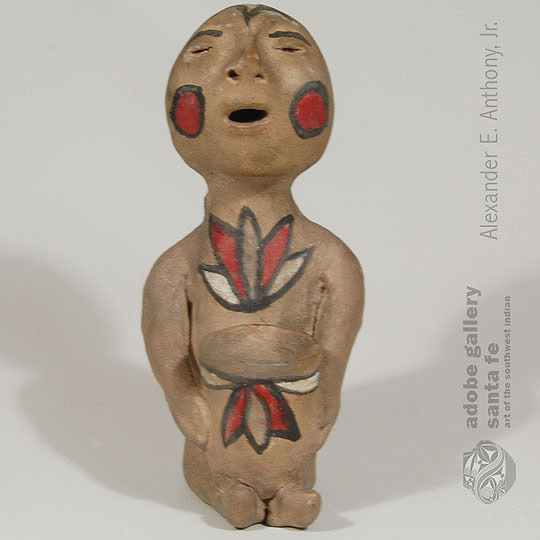 Some of the important curio dealers in and around Santa Fe in the late 1800s and early 1900s were Jake Gold, Abe Gold, J. S. Candelario, and Francis E. Lester. Research by Kathleen Howard and Diana Pardue in preparation for publishing Inventing the Southwest, revealed an order from Candelario's shop ". . .a baggage car with about 200 assorted small pieces of pottery, which we can sell at retail from 15 cents to 25 cents" (September 1904) and "one hundred Tesuque pottery gods, small size, and fifty of the larger size black gods" (April 1905). The following year, the Fred Harvey Company ordered "100 small rain gods, three dozen larger ones." Anderson p.70
Some of the important curio dealers in and around Santa Fe in the late 1800s and early 1900s were Jake Gold, Abe Gold, J. S. Candelario, and Francis E. Lester. Research by Kathleen Howard and Diana Pardue in preparation for publishing Inventing the Southwest, revealed an order from Candelario's shop ". . .a baggage car with about 200 assorted small pieces of pottery, which we can sell at retail from 15 cents to 25 cents" (September 1904) and "one hundred Tesuque pottery gods, small size, and fifty of the larger size black gods" (April 1905). The following year, the Fred Harvey Company ordered "100 small rain gods, three dozen larger ones." Anderson p.70
In the period 1900-1910, cream-slipped rain gods were prevalent and probably dominated the orders for hundreds of dolls by the merchants. This rain god doll with its bright red cheeks was the style being made during that decade. He has a white feather on his head, a red and white design on his chest and red and white designs on his jar.
Would you like to purchase or read more about this Rain God?
Multi-colored Tesuque Pueblo Rain God - 25996
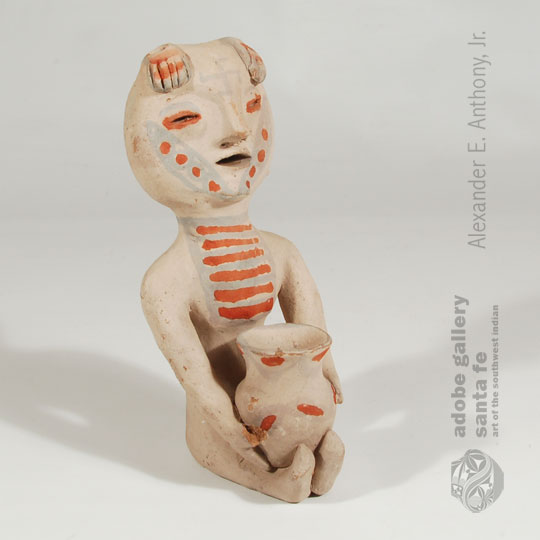 Tesuque Rain Gods are well understood by our clients so I will not delve into their history too much. It is only necessary to point out that this one is probably from the late 1800s, maybe 1890, and is unusual in its decoration.
Tesuque Rain Gods are well understood by our clients so I will not delve into their history too much. It is only necessary to point out that this one is probably from the late 1800s, maybe 1890, and is unusual in its decoration.
Nineteenth Century Tesuque Pueblo Rain God Figurine - 26001
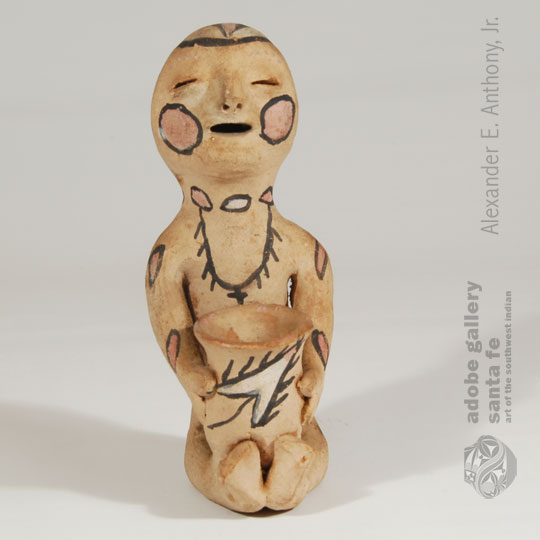 This Nineteenth Century Tesuque Pueblo Rain God Figurine has a cream slip and is highly decorated with painted designs. He wears a cross necklace, painted feather on his head, rosy cheeks, marks on his arms and neck and decorations on his jar.
This Nineteenth Century Tesuque Pueblo Rain God Figurine has a cream slip and is highly decorated with painted designs. He wears a cross necklace, painted feather on his head, rosy cheeks, marks on his arms and neck and decorations on his jar.
Would you like to purchase or read more about this Rain God?
Tesuque Pueblo Hear No Evil Micaceous Rain God, circa 1900 - 25999
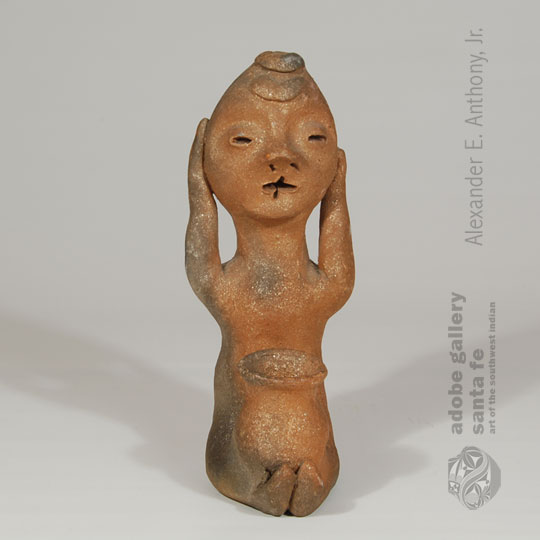 Micaceous slipped rain god figures date to as early as 1893, as evidenced by one example exhibited at the Colombian Exposition in Chicago that year. They continued to be made until 1905, and were revived by potters in the 1960s.
Micaceous slipped rain god figures date to as early as 1893, as evidenced by one example exhibited at the Colombian Exposition in Chicago that year. They continued to be made until 1905, and were revived by potters in the 1960s.
There were also a series of rain gods modeled after the proverb See No Evil, Hear No Evil, and Speak No Evil. This rain god figurine is the Hear No Evil variety. It likely dates to circa 1900. He has sculpted hair hanging over his forehead.
Would you like to purchase or read more about this Rain God?
Original Chamisa Landscape Painting “Glowing Sunset” by Robert Daughters - C3967A
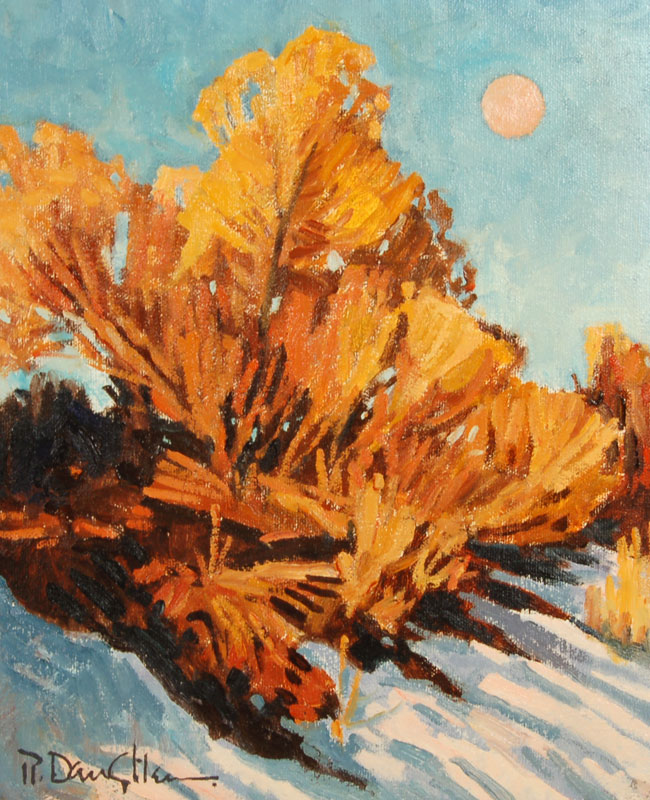 Robert Daughters specialized in painting landscapes and people of Northern New Mexico, Arizona and Mexico. At one time, he lived in Taos, New Mexico. He then shared his time between the Sea of Cortez in Mexico and the Catalina foothills of Tucson, Arizona. He passed away in 2013.
Robert Daughters specialized in painting landscapes and people of Northern New Mexico, Arizona and Mexico. At one time, he lived in Taos, New Mexico. He then shared his time between the Sea of Cortez in Mexico and the Catalina foothills of Tucson, Arizona. He passed away in 2013.
When Daughters lived in Taos, it was in a house built by Oscar E. Berninghaus. Daughters was a co-founder of the group of artists known as the Taos Six. The others with him in this group were Walt Gonske, Rod Gobels, Ron Bursano, Ray Vinalla and Julian Robles.
Would you like to purchase or know about this painting?
Historic Tesuque Pueblo Black on Red Jar with Avanyu - C3924L
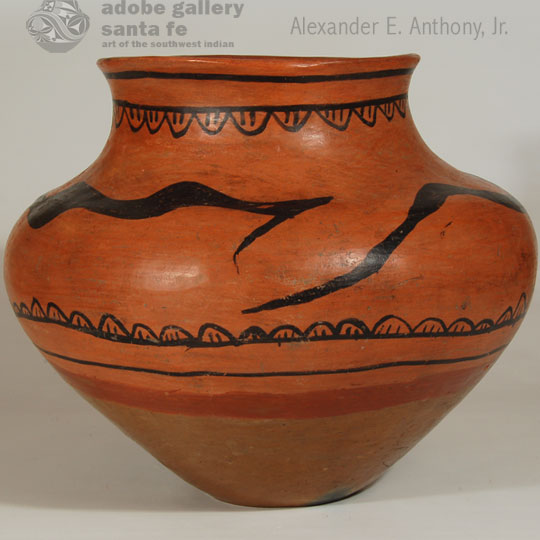 It is often difficult to distinguish historic pottery made at San Ildefonso from that made at Tesuque Pueblo. Both pueblos traditionally produced Black-on-red pottery like this jar and it has always been similar. Sometimes, the distinguishing factor is the natural tan underbody of the jar. Neither pueblo applied a slip to the underbody, but only stone polished it. The underbody is sometimes bumpy on Tesuque wares and smoother on San Ildefonso wares, however, that may not always be a determining factor.
It is often difficult to distinguish historic pottery made at San Ildefonso from that made at Tesuque Pueblo. Both pueblos traditionally produced Black-on-red pottery like this jar and it has always been similar. Sometimes, the distinguishing factor is the natural tan underbody of the jar. Neither pueblo applied a slip to the underbody, but only stone polished it. The underbody is sometimes bumpy on Tesuque wares and smoother on San Ildefonso wares, however, that may not always be a determining factor.
Tesuque Black-on-red pottery is fashioned in the same manner as Polychrome pottery. Clay, temper, paste, and construction do not differ. The difference arises when a red slip is wiped on the vessel in lieu of a cream slip.
Would you like to purchase or read more about this historic pottery?
Rare Historic Aguilar Kewa Pueblo Black on Red Jar - C3945B
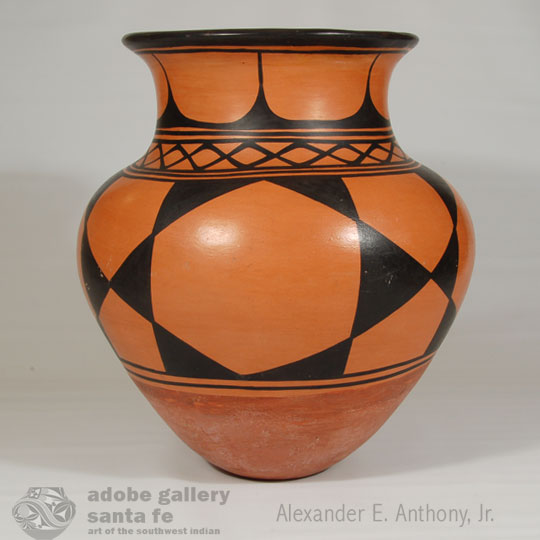 The Aguilar sisters-Asunción Aguilar Caté and Felipita Aguilar Garcia-and their sister-in-law, Mrs. Ramon Garcia, were exceptional potters in the late 19th and early 20th century periods at Santo Domingo Pueblo (now Kewa Pueblo). They followed tradition in their early works in that designs on their pottery were typical strong black geometrics on creamy white slip. According to some records, sales of pottery of all potters drastically slowed around 1910 and Mr. Seligman, trader at the post at Santo Domingo, suggested to potters that they try developing something different to see if that would spur sales.
The Aguilar sisters-Asunción Aguilar Caté and Felipita Aguilar Garcia-and their sister-in-law, Mrs. Ramon Garcia, were exceptional potters in the late 19th and early 20th century periods at Santo Domingo Pueblo (now Kewa Pueblo). They followed tradition in their early works in that designs on their pottery were typical strong black geometrics on creamy white slip. According to some records, sales of pottery of all potters drastically slowed around 1910 and Mr. Seligman, trader at the post at Santo Domingo, suggested to potters that they try developing something different to see if that would spur sales.
Historic San Ildefonso Pueblo Polychrome Pictorial Jar - C3945C
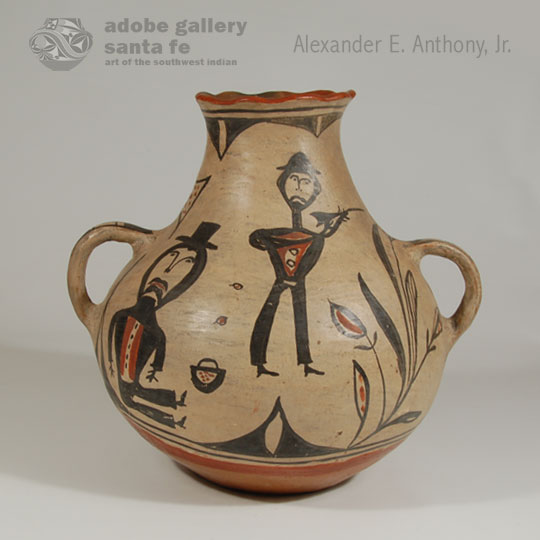 An analysis of the pictorial elements is subjective but it appears that the standing male is holding a rifle over his left shoulder in anticipation of shooting the deer on the opposite side of the jar. The beard and mustache, black hat, and black clothing would indicate the potter was picturing a local Spaniard. The seated male is similarly pictured, probably intended to represent another Spaniard. What the seated male represents remains a mystery, as does the small container next to him. Is it a doctor's medicine bag?
An analysis of the pictorial elements is subjective but it appears that the standing male is holding a rifle over his left shoulder in anticipation of shooting the deer on the opposite side of the jar. The beard and mustache, black hat, and black clothing would indicate the potter was picturing a local Spaniard. The seated male is similarly pictured, probably intended to represent another Spaniard. What the seated male represents remains a mystery, as does the small container next to him. Is it a doctor's medicine bag?
To truly understand what the potter had in mind, we would have to be present around circa 1890 and understand what was happening at San Ildefonso Pueblo. Was there animosity between the Puebloans and the Spaniards or was the potter having a moment of levity and lightheartedness? I choose to think she was enjoying her play on her Spanish neighbors and that the jar was made in good humor. It is an amazing work of art and perhaps a moment in history.
Would you like to purchase or read more about this pottery?
Historic Fine and Exuberant Zia Pueblo Jar with Zuni Designs - C3924N
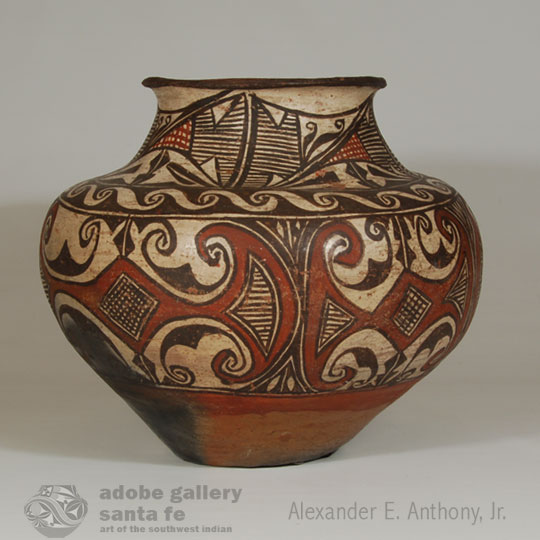 Zia potters have been consistent in producing beautiful and strong pottery vessels, both for use in their homes and for sale to tourists. Potters, today, still prefer to use ollas for water as the porous jars allow for seepage through the walls which cools the water. The clay sweetens the taste of water.
Zia potters have been consistent in producing beautiful and strong pottery vessels, both for use in their homes and for sale to tourists. Potters, today, still prefer to use ollas for water as the porous jars allow for seepage through the walls which cools the water. The clay sweetens the taste of water.
Traditional shapes and decorative style have changed very little at Zia since the 1700s. Tradition is hard to break.
One must wonder why a potter, around 1890, would make a jar that resembles the shape of those made by the Tewa potters and then place on it designs that obviously are of Zuni origin. There is nothing to make one think this is a Zia jar, except for the tell-tale sign of basalt temper. It is strikingly beautiful and certainly a work of art by a talented and creative potter. If only we knew who she was or what made her depart from the traditions of Zia to create such a beautiful jar!
Would like to purchase or read more about this Zia Pueblo pottery?
Historic Four-color Polychrome Olla from Zia Pueblo - C3328B
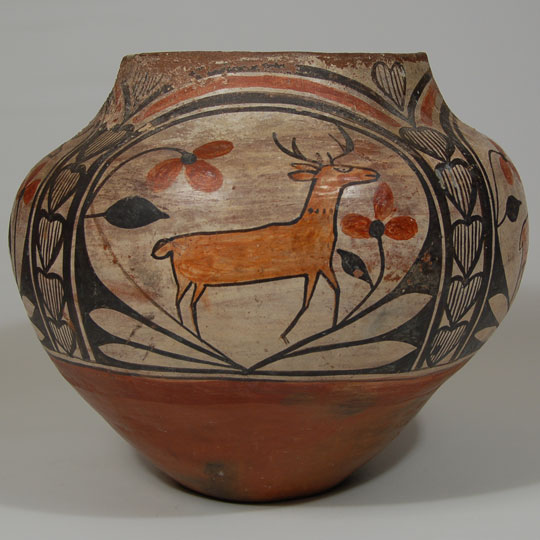 There is precedence for picturing animals on pueblo pottery-namely the Mimbres, in the 1100s, featured insects, fish, birds, and large and small animals primarily on the interior of bowls. There was then a large time span before animals appeared again, this time in the late-1800s on Zuni Pueblo pottery in the form of heartline deer figures. It could be that this inspired potters to paint deer on Zia Pueblo pottery. According to Harlow and Lanmon, the earliest documented Zia pottery with deer designs is 1870s.
There is precedence for picturing animals on pueblo pottery-namely the Mimbres, in the 1100s, featured insects, fish, birds, and large and small animals primarily on the interior of bowls. There was then a large time span before animals appeared again, this time in the late-1800s on Zuni Pueblo pottery in the form of heartline deer figures. It could be that this inspired potters to paint deer on Zia Pueblo pottery. According to Harlow and Lanmon, the earliest documented Zia pottery with deer designs is 1870s.
This jar is probably from the first quarter of the 20th century. The design is divided into four quadrants, each of which contains basically the same design. There is an orange colored deer outlined in black. The deer is housed in an arch similar to that seen on Zuni pottery. There is what may be a rainbow arch above the deer house, flowers inside with the deer and black outlined hearts separating the four quadrants. Each heart is filled with parallel vertical black lines.
Would like to purchase or read more about this Zia Pueblo pottery?
Zia Pueblo Pottery Pictorial Tile by Diana Pino Lucero - C3954A
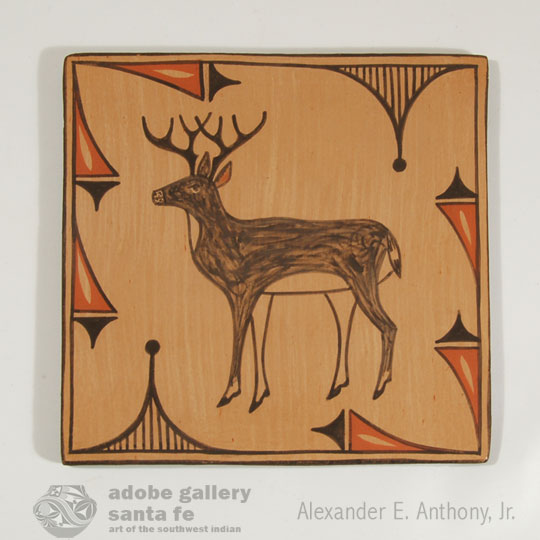 This square Zia tile features a very realistic and artistic deer, head held high, motionless, and unafraid. The deer is the focal point of the tile. There is no ground plane, no trees, or other distracting items to draw attention away from the deer. Traditional Zia pottery designs outline the edges of the tile. The slip is a warm cream color on the front. Red stone-polished slip covers the back. The tile is signed with the artist's name and pueblo name.
This square Zia tile features a very realistic and artistic deer, head held high, motionless, and unafraid. The deer is the focal point of the tile. There is no ground plane, no trees, or other distracting items to draw attention away from the deer. Traditional Zia pottery designs outline the edges of the tile. The slip is a warm cream color on the front. Red stone-polished slip covers the back. The tile is signed with the artist's name and pueblo name.
Diana Pino Lucero is the adopted daughter of John and Vicentita Shije Pino. The Pinos had married in 1934. They had one son, José Hilario, and adopted three children, Diana being the only female. Diana learned pottery techniques from Vicentita. She has won awards at Santa Fe Indian Market, exhibited at Heard Museum Show, Northern Indian Pueblos Arts & Crafts Show; Walatowa Arts Festival at Jemez Pueblo, New Mexico State Fair and other venues.
Would you like to purchase or read more about this Zia Pueblo pottery?
Historic Zia Pueblo Traditional Serving Bowl, circa 1890-1900 - C3925Y
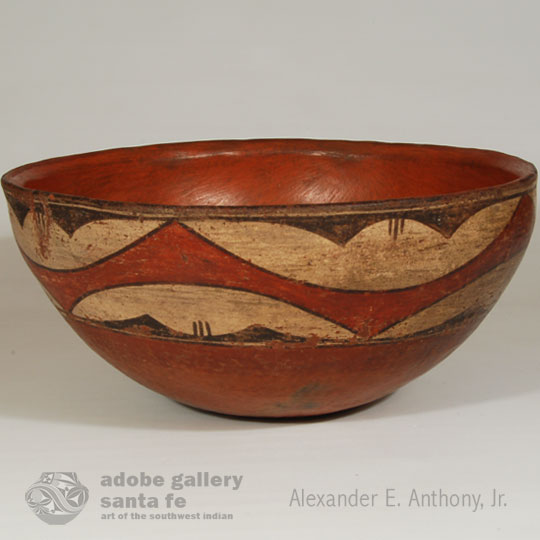 This Zia Pueblo bowl dates to around 1890-1900. Its main element of design is the red undulating band encircling the bowl. Above it are clouds and below it are water forms. A wide red band was wiped on under the design panels. Such wiped on bands got thinner over time and discontinued around 1935.
This Zia Pueblo bowl dates to around 1890-1900. Its main element of design is the red undulating band encircling the bowl. Above it are clouds and below it are water forms. A wide red band was wiped on under the design panels. Such wiped on bands got thinner over time and discontinued around 1935.
The rim of the bowl flares outward slightly, a feature seen on bowls made for pueblo use more often than on bowls made for sale. Serving bowls like this one were often used to work small amounts of bread dough and allow the dough to rise.
Would like to purchase or read more about this historic Zia Pueblo pottery?
Navajo Original Painting “Going to the Rodeo” by Beatien Yazz - C3242A
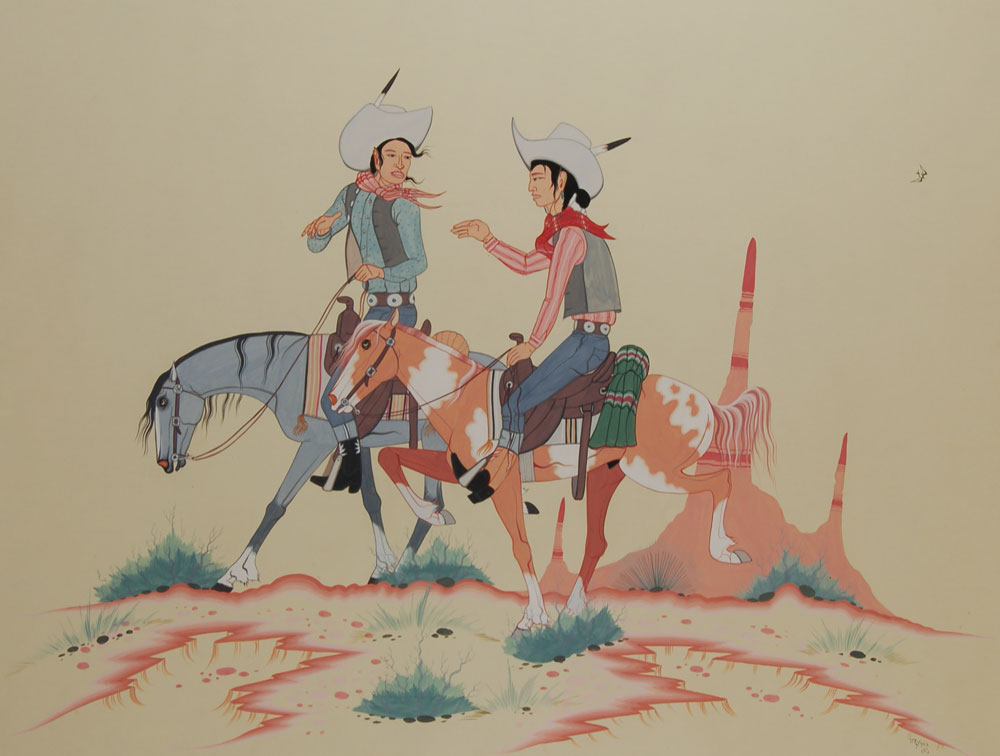 No artist can portray the daily activities of the Navajo Reservation as well as Beatien Yazz, who, having grown up on the Reservation, was well familiar with the daily activities and he has always portrayed them with young features in a grown-up appearance.
No artist can portray the daily activities of the Navajo Reservation as well as Beatien Yazz, who, having grown up on the Reservation, was well familiar with the daily activities and he has always portrayed them with young features in a grown-up appearance.
This painting of two young Navajo men, casually riding their horses and chatting while on their way to the rodeo, is presented in Yazz's traditional style. Each is dressed in traditional garb of the times-cowboy boots, vest over the shirt, concha belt, Levi trousers, neck scarf and a large cowboy hat. His use of soft, almost pastel, paints blends the subjects well into the desert landscape. The lack of background subjects, except for the single rock formation, reinforces the starkness of the desert.
Would you like to purchase or read more about this painting?

Very Large Hopi Pueblo Polychrome Pictorial Storage Jar - 25994
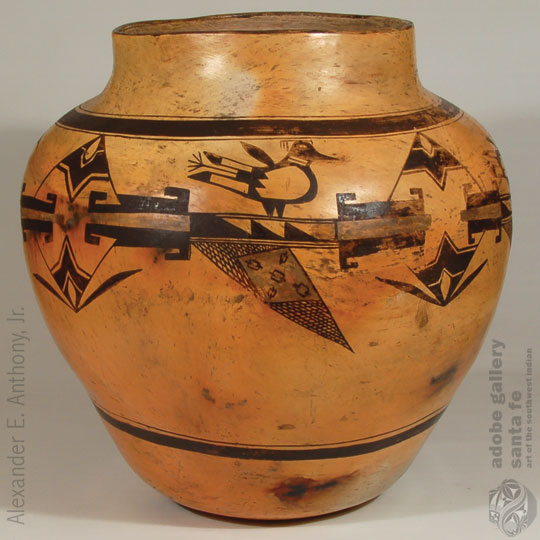 When a magnificent Hopi jar surfaces, the temptation is to try to assign the name of the maker. Most often, there are clues that lead one to select a maker-clues such as vessel shape, certain design elements, and age, perhaps-but it is not always so clear cut. When this jar came to us, our first guess was that it could have been made by Daisy Hooee Nampeyo (1920-1990), daughter of Annie Healing Nampeyo and granddaughter of Nampeyo, however we now believe it dates too early to have been made by her.
When a magnificent Hopi jar surfaces, the temptation is to try to assign the name of the maker. Most often, there are clues that lead one to select a maker-clues such as vessel shape, certain design elements, and age, perhaps-but it is not always so clear cut. When this jar came to us, our first guess was that it could have been made by Daisy Hooee Nampeyo (1920-1990), daughter of Annie Healing Nampeyo and granddaughter of Nampeyo, however we now believe it dates too early to have been made by her.
<!-- /* Font Definitions */ @font-face {font-family:Verdana; panose-1:2 11 6 4 3 5 4 4 2 4; mso-font-charset:0; mso-generic-font-family:auto; mso-font-pitch:variable; mso-font-signature:-1593833729 1073750107 16 0 415 0;} @font-face {font-family:"Cambria Math"; panose-1:2 4 5 3 5 4 6 3 2 4; mso-font-charset:0; mso-generic-font-family:auto; mso-font-pitch:variable; mso-font-signature:-536870145 1107305727 0 0 415 0;} @font-face {font-family:Calibri; panose-1:2 15 5 2 2 2 4 3 2 4; mso-font-charset:0; mso-generic-font-family:auto; mso-font-pitch:variable; mso-font-signature:-536870145 1073786111 1 0 415 0;} /* Style Definitions */ p.MsoNormal, li.MsoNormal, div.MsoNormal {mso-style-unhide:no; mso-style-qformat:yes; mso-style-parent:""; margin:0in; margin-bottom:.0001pt; mso-pagination:widow-orphan; font-size:12.0pt; font-family:"Times New Roman"; mso-fareast-font-family:Calibri; mso-fareast-theme-font:minor-latin;} .MsoChpDefault {mso-style-type:export-only; mso-default-props:yes; font-family:Calibri; mso-ascii-font-family:Calibri; mso-ascii-theme-font:minor-latin; mso-fareast-font-family:Calibri; mso-fareast-theme-font:minor-latin; mso-hansi-font-family:Calibri; mso-hansi-theme-font:minor-latin; mso-bidi-font-family:"Times New Roman"; mso-bidi-theme-font:minor-bidi;} @page WordSection1 {size:8.5in 11.0in; margin:1.0in 1.0in 1.0in 1.0in; mso-header-margin:.5in; mso-footer-margin:.5in; mso-paper-source:0;} div.WordSection1 {page:WordSection1;} --> Part of the A Century of Hopi-Tewa Pottery: From Nampeyo of Hano to Mark Tahbo exhibit.
Would you like to purchase or read more about this Hopi Pueblo Pottery?
Hopi-Tewa Very Large Polychrome Seed Jar by Grace Chapella - C3960C
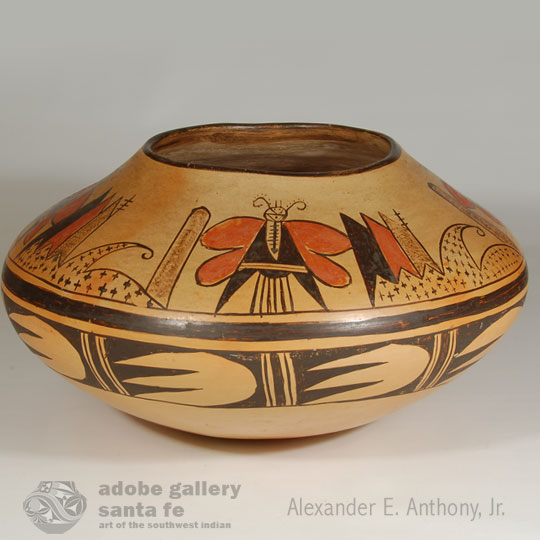 Grace Chapella was born in the Tewa village of Hano at First Mesa on the Hopi Reservation in 1874, eight years before the Reservation was established as such, and before Custer's Last Stand at the Battle of the Little Big Horn. She witnessed the first "horseless carriage" arrive on the Reservation and recalled how frightening it was. In 1927, she became the first person from the Hopi Reservation to fly in an airplane, going from Grand Canyon to Long Beach for a pottery demonstration.
Grace Chapella was born in the Tewa village of Hano at First Mesa on the Hopi Reservation in 1874, eight years before the Reservation was established as such, and before Custer's Last Stand at the Battle of the Little Big Horn. She witnessed the first "horseless carriage" arrive on the Reservation and recalled how frightening it was. In 1927, she became the first person from the Hopi Reservation to fly in an airplane, going from Grand Canyon to Long Beach for a pottery demonstration.
Having lived for over a century-she passed away at age 107-Chapella (pronounced Tsepela) witnessed many changes in her life at Hopi where she lived. She was a youngster at a time before trading posts and tourists were introduced to the reservation and lived to see both flourish and the demand for pottery grow at leaps and bounds. Although her pottery, and that of others at First Mesa, is referred to as Hopi pottery, technically it is Hopi-Tewa potteryas the residents of Hano Village at First Mesa are Tewa-speaking Indians originally from New Mexico.
<!-- /* Font Definitions */ @font-face {font-family:Verdana; panose-1:2 11 6 4 3 5 4 4 2 4; mso-font-charset:0; mso-generic-font-family:auto; mso-font-pitch:variable; mso-font-signature:-1593833729 1073750107 16 0 415 0;} @font-face {font-family:"Cambria Math"; panose-1:2 4 5 3 5 4 6 3 2 4; mso-font-charset:0; mso-generic-font-family:auto; mso-font-pitch:variable; mso-font-signature:-536870145 1107305727 0 0 415 0;} @font-face {font-family:Calibri; panose-1:2 15 5 2 2 2 4 3 2 4; mso-font-charset:0; mso-generic-font-family:auto; mso-font-pitch:variable; mso-font-signature:-536870145 1073786111 1 0 415 0;} /* Style Definitions */ p.MsoNormal, li.MsoNormal, div.MsoNormal {mso-style-unhide:no; mso-style-qformat:yes; mso-style-parent:""; margin:0in; margin-bottom:.0001pt; mso-pagination:widow-orphan; font-size:12.0pt; font-family:"Times New Roman"; mso-fareast-font-family:Calibri; mso-fareast-theme-font:minor-latin;} .MsoChpDefault {mso-style-type:export-only; mso-default-props:yes; font-family:Calibri; mso-ascii-font-family:Calibri; mso-ascii-theme-font:minor-latin; mso-fareast-font-family:Calibri; mso-fareast-theme-font:minor-latin; mso-hansi-font-family:Calibri; mso-hansi-theme-font:minor-latin; mso-bidi-font-family:"Times New Roman"; mso-bidi-theme-font:minor-bidi;} @page WordSection1 {size:8.5in 11.0in; margin:1.0in 1.0in 1.0in 1.0in; mso-header-margin:.5in; mso-footer-margin:.5in; mso-paper-source:0;} div.WordSection1 {page:WordSection1;} --> Part of the A Century of Hopi-Tewa Pottery: From Nampeyo of Hano to Mark Tahbo exhibit.
Would like to purchase or read more about this Chapella pttery?

Sikyatki-style Contemporary Hopi Pueblo Seed Jar by Garnet Pavatea - C3960B
Garnet Pavatea was known as Flower Girl and she was a Hopi-Tewa from the Tewa Village on First Mesa. Her dad, Dewakuku, was Hopi and her mother was Tewa. Following tradition, Garnet was of her mother's clan.
This seed jar of the Sikyatki-shape is a shining example of her expert craftsmanship in vessel construction and her artistic talent in designing and painting a jar. She extended the red paint on the rim down into the interior of the jar, a step not necessary, but one that demonstrates her attention to detail. The jar was constructed from all native materials and fired in a traditional outdoor firing. It is signed Garnet Pavatea on the underside.
Part of the A Century of Hopi-Tewa Pottery: From Nampeyo of Hano to Mark Tahbo exhibit.
To purchase or read more about this Nampeyo pottery.
Tall Hopi Pueblo Cylinder with Clay Appliqué at Rim by Nampeyo of Hano - C3960A
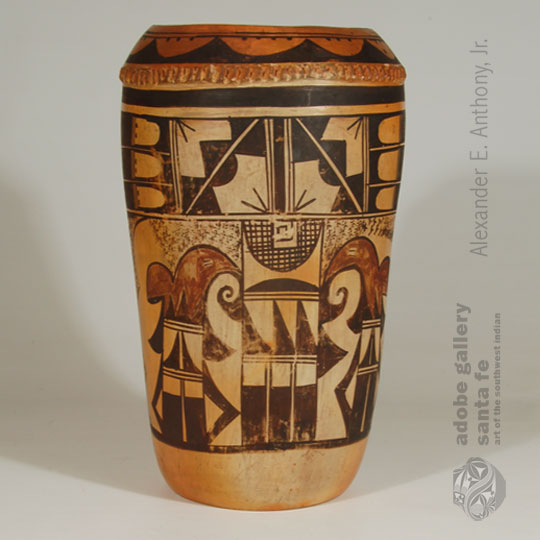 In the 1900-1910 periods, Nampeyo was potting at her prime. She was creative and continually improvising more varied work than in any earlier or later period. By the 1910 decade, she was producing for a collector market and was producing outstanding quality but with less improvisation. By the 1930s, she was producing more tactile work as her eyesight was failing.
In the 1900-1910 periods, Nampeyo was potting at her prime. She was creative and continually improvising more varied work than in any earlier or later period. By the 1910 decade, she was producing for a collector market and was producing outstanding quality but with less improvisation. By the 1930s, she was producing more tactile work as her eyesight was failing.
Sometime in the late 1800s, Nampeyo sometimes added a row or rows of clay appliqué to her pottery. There is one in the Milwaukee Museum with a collection date of 1895. This magnificent very large cylindrical jar features such a ring of clay near the rim. It is typical of Nampeyo's construction, as she is known for introducing the tall shapes.
Part of the A Century of Hopi-Tewa Pottery: From Nampeyo of Hano to Mark Tahbo exhibit.
To purchase or read more about this Nampeyo pottery.
A Century of Hopi-Tewa Pottery: From Nampeyo of Hano to Mark Tahbo Exhibit
Adobe Gallery's special exhibit "A Century of Hopi-Tewa Pottery: From Nampeyo of Hano to Mark Tahbo" will open Monday, August 7, with reception at 221 Canyon Road from 5 to 7pm.
Legendary Hopi matriarch Nampeyo of Hano used designs created by her prehistoric ancestors to bring Hopi pottery to the masses in the early 1900s. Today, Hopi potters like Mark Tahbo use Nampeyo's designs as inspiration for their new works. This exhibit, which features works by both of these potters and many others who produced between them, will showcase the ways that today's artists continue to be influenced by those of yesteryear.
With this exhibit, we wish to shine a light on the link between New Mexico Pueblo Indians and the pottery being produced today at Hopi. The majority of the potters whose works we feature in this exhibit are Hopi-Tewa people-the descendants of those who migrated to Hopi from New Mexico's Tano Pueblo in the 1690s.
Would you like to purchase or view the show?
Santa Clara Pueblo Copper Plate Etching “The Healers” by Helen Hardin - C3943C
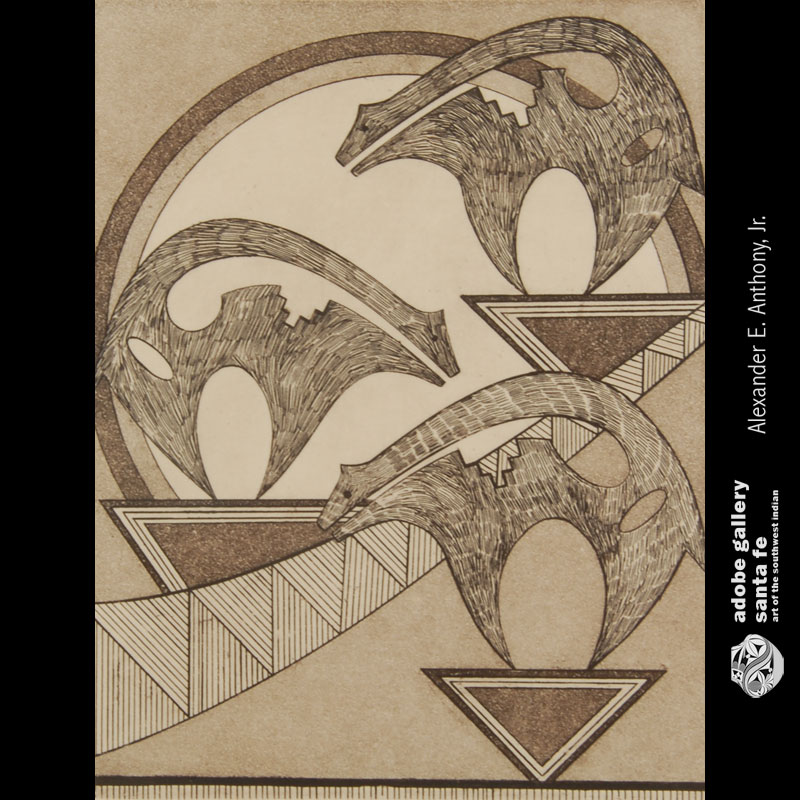 Tewa Pueblo legend states that bears have the power to heal. They are considered medicine men. Santa Clara Pueblo artist Helen Harden drew three arched bears in this etching for which she named it "The Healers." The bears are in the curved style made famous by San Ildefonso potter, Tony Da. Each bear stands on a triangular pedestal.
Tewa Pueblo legend states that bears have the power to heal. They are considered medicine men. Santa Clara Pueblo artist Helen Harden drew three arched bears in this etching for which she named it "The Healers." The bears are in the curved style made famous by San Ildefonso potter, Tony Da. Each bear stands on a triangular pedestal.


